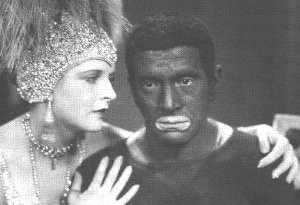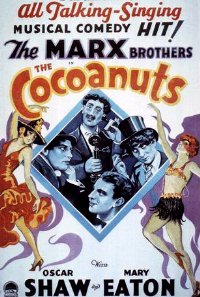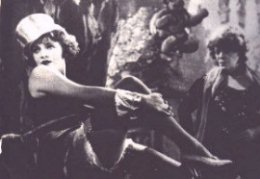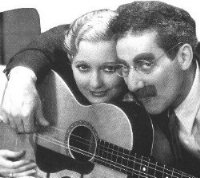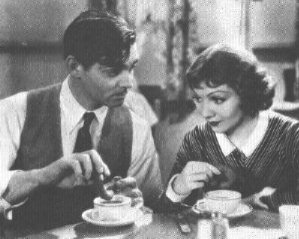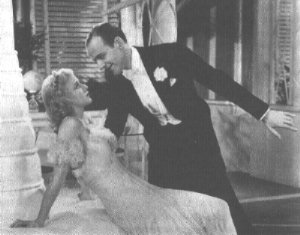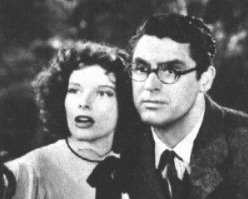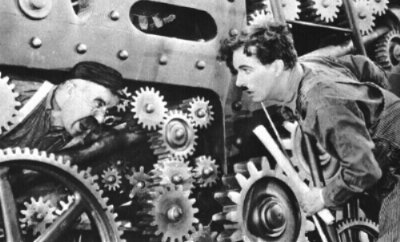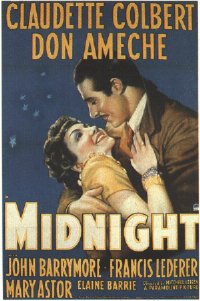 | Black & White: the coming of sound |
|
|
|
|
|
The Blue Angel |
Little Caesar |
Monkey Business |
|
It Happened One Night |
The Gay Divorcee |
Bringing Up Baby |
|
|
Modern Times |
|
The Jazz Singer -adopted Broadway play
New Genres and Old:
Musicals (surreal sophistication, fantasias through kaleidoscopic Lencec, highky expressive camera movement, and sophisticated montage, closer to an experimental cinema of abstract impressionism than to anything in the traditional narrative films, integration of musoc and dance- the major ganre of 1930s cinema:
1933 -42nd Street (Lloyd Bacon)
1933 -Gold Diggers (Mervyn LeRoy)
1933 - Flying Down to Rio (Thornton Freeland)
1933 - Footlight Parade(Lloyd Bacon)
1934 - DamesRay Enright)
1934 - The Gay Divircee (Mark Sandric)
1935 Roberta (William Seiter)
1935 - Top Hat (Mark Sandrich)
1935 - In Caliente (Bushby Berkeley)
1936 - Swing Time (George Stewens)
1936 - Follow the Fleet (Mark Sandrich)
1937 - A Damsel in Distress (George Stewens)
1937 - Shall We Dance (Mark Sandrich)
1938 - Carefree (Mark Sandrich)
1939 - The Story of Vernon and Irene Castle (H.C.Potter)
Walt Disney (1901-1966) - "animated musical"
1929 - The Skeleton dance
"Mickey Mousing"
The new realism and urban gangster films with brutal violence or a gangster as a "tragic hero" or as social victum:
1928 - The Racket (Lewis Milestone)
1927 - Underworld (Josef von Sternberg)
1930 - Little Caesar (Melvyn LeRoy)
1931 - The Public Enemy (William Wellman)
1932 - Scarface (Howard Hawks)
1937 - San Quentin ( Lloyd Bacon)
1937 - Dead End (William Wyler)
1937 - You Only Live Once (Fritz Lang)
1938 - Angels with Dirty Faces (Michel Curtiz)
Another tough-talking, realistic cycle:
1931 - The Front Page (Lewis Milestone)
1931 - Five Star Final (Mervyn LeRoy)
1931 -Scandal Sheet (John Cromwell)
1931 - Platinum Blonde (Frank Capra)
1940- His Girl Friday (Howard Hawks)
The historical biography:
1933 - The Private Life of Henry VIII ((Alexander Corda)
1933 - Voltaire (John Adolfi)
1933 -Queen Christina (Rouben Mamoulian)
1934 - Viva Villa! (Howard Hawks)
1934 - House of Rothschild (Alfred Werker)
1934 - Catherine the Great (Paul Czinner)
1935 - Cardinal Richelieu (Rowland V.Lee)
1936 - Rembrandt (Alexander Korda)
1936 Lloyd''s of London (Henry King)
1938 -Marie Antoinette (W.S.Van Dyke)
1939 - The Private Lifes of Elizabeth and Essex (Michael Curtiz)
1937 - The Life of Emile Zola (William Dieterle)
Anarchic dialoque comedies of the Marx Brothers and screwball comediesof such directors as Frank Capra (Platinum Blonde 1931, Lady for a day 1933, It Happened One Night 1934, You Can''t Take It with You 1938) and Howard Hawks (Twentieth Centure 1934, Bringing Up Baby 1938, His Girl Friday 1940). Other screwball comedies
1931 - Private Life (Sidney Franklin)
1935 - The Good Fairy (William Wyler)
1936 _Theodora Goes Sacred (Richard Boleslavsky)
1937 - easy Living (Mitchell Leisen)
1939 - Midnight (Mitchell Leisen)
Dark Social Satire - Preston Sturges
1941 - Christmas in July
1942 - The Palm Beach story
1940 - The Lady Eva
1944 - The Miracle of Morgan''s Creek
1944 - Hail The Conquering Hero
1941 -Sillivan''s Travels
1940- The Great McGinty
Wartime and Postwar Cinema 1940-51
The Effect of War
1. Paralysis of film industry during the war, or the industry was reduced.
2.Psychological and moral collapse.
HOLLYWOOD AT WAR
Like Italian cinema, American film had been moving toward a kind of realism in 1940s.On December 18, 1941, immediately following the attack on Pear Harbor and American''s declaration of war upon Japan< President established BMPA 9Bureau of Motion Picture Affairs) for Office of War Information OWI.
Major Hollywood Directors had been recruited into the armed forces, together with professional documentarists to operate programs, and films. The seven films of the "Why We Fight" series (Frank Capra, 1942), The Nazis Strike (Capra-Litvac, 1942), The Battle of Britian (Capra end ets) - were documentaries edited from stock footage about the war.
1943-44:many film presentation of the war portrayed the dangers of Fascism:
Meet John Doe (Capra)
Ministry of Fear (Fritz Lang)
Lifeboat (Alfred Hichcock)
Another group of films provided a more realistic treatment than heretofore
Hangmen Also Die (Fr.Lang)
Edge of Darkness (Lewis Milestone)
This Land Is Mine (Jean Renoir)
Song of Russia (Gregory Ratoff)
Mission of Moscow (Michael Curtiz)
In 1945, however, Hollywood was more concerned with metaphysical defeat - postwar.500-1700 films made during this period.The worst of times for human history have been the best of times for the cinema, even bad cinema.
Postwar Boom.
Hollywood was powerful studio production system, making the American the only major national cinema in the West to preserve a direct continuity of tradition with its part after 1945.Only America was in a material position to provide high-quality films to a world hungryfor diversion.
Hollywood - 30s
B&W films 50s
Marx Brothers
The Jazz Singer
Milestones in Classic Hollywood

